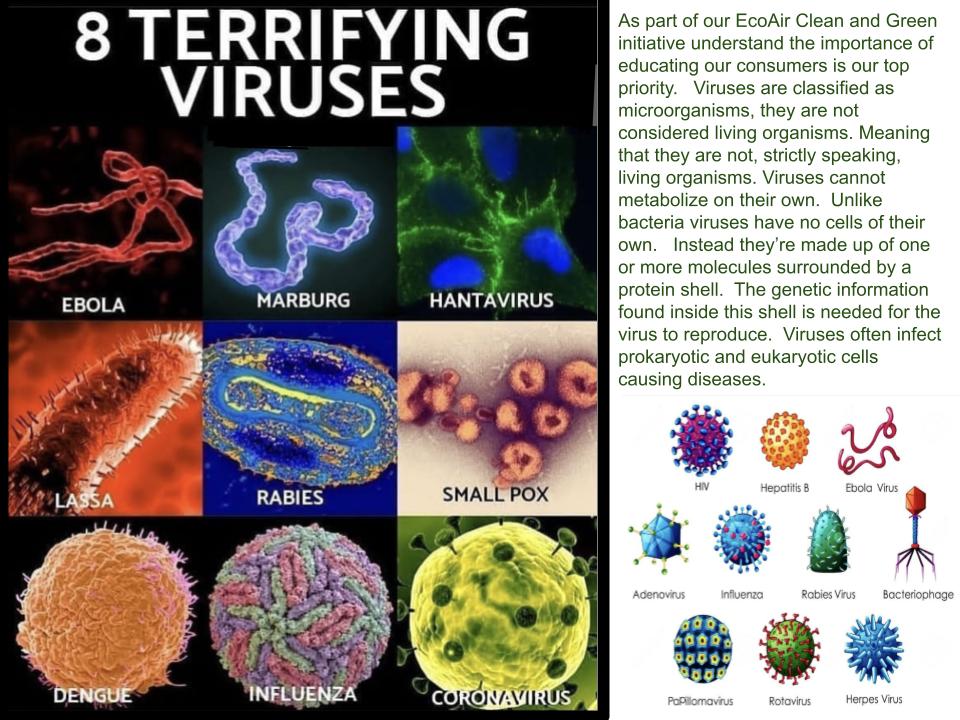Clean & Green Educational Movement
At EcoAir Clean & Green, we recognize the importance of educating consumers about a truly green initiative.
The EPA
The EPA registers products that kill microorganisms on surfaces as pesticides. Before manufacturers can sell pesticides in the United States, the EPA must evaluate them thoroughly to ensure that they meet federal safety standards to protect human health and the environment. The EPA will grant a “registration” or license that permits a pesticide’s distribution, sale, and use only after the company meets the scientific and regulatory requirements.
Surface disinfectants are considered pesticides. Disinfectants kill bacteria, viruses, and fungi. According to the EPA, these are considered pests just as insects, weeds, snails, and slugs are considered pests. Therefore, the EPA classifies disinfectants and sanitizers as pesticides.
What does the FDA approve?
New drugs and certain biologics must be proven safe and effective to the FDA’s satisfaction before companies can market them. Manufacturers must also be able to prove they can make the drug product according to federal quality standards.
The FDA doesn’t approve companies.
The FDA does not “approve” health care facilities, laboratories, or manufacturers. However, the FDA does have the authority to inspect regulated facilities to verify they comply with applicable good manufacturing practice regulations. Owners and operators of domestic or foreign food, drug, and most device facilities must register their facilities with the FDA.
Conclusion
The EPA registers products that kill micro-organisms on surfaces as pesticides. The FDA regulates products used on humans, such as hand sanitizers and antibacterial soaps. An easy way to remember this is the Environmental Protection Agency regulates products used in the environment around you, such as workspace, the store, hospital, or even home. The Food and Drug Administration mostly regulates products that go in or on your body, the way food and drugs are typically used.
PRN 2000-1: Applicability of the Treated Articles Exemption to Antimicrobial Pesticides
EcoAir Clean & Green falls into the PRN 2000-1 category since we are not a pesticide.
This notice clarifies EPA policy with respect to the scope of the "treated articles exemption" in 40 CFR 152.25(a). This exemption covers qualifying treated articles and substances bearing claims to protect the article or substance itself. EPA does not regard this exemption as including articles or substances bearing implied or explicit public health claims against human pathogens.
This notice addresses the types of claims that are not permitted for antimicrobial pesticide products exempt from registration under this provision and gathers together in one place guidance the agency has offered on labeling statements it believes would or would not be covered under this provision. This notice also explains the requirement that the pesticide in a treated article be "registered for such use."
This notice provides guidance to producers and distributors of pesticide-treated articles and substances, and to producers and distributors of pesticides used as preservatives to protect treated articles from microbial deterioration.
Pesticides and Human Health:
Pesticides can cause short-term adverse health effects, called acute effects, as well as chronic adverse effects that can occur months or years after exposure. Examples of acute health effects include stinging eyes, rashes, blisters, blindness, nausea, dizziness, diarrhea, and death.
Pesticides can be harmful to human health. Pesticides have been proven to cause reproductive and developmental effects, cancer, kidney and liver damage, endocrine disruption, etc. ... Research shows that children are even exposed to pesticides in utero.

